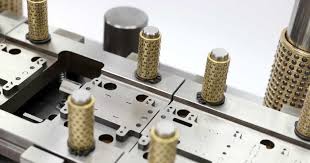
The process of steel stamping transforms basic metal materials into exact shapes through its exceptional operations. Different industries depend on stamping to produce car components, home appliances, and other functional objects. This blog will help you explain the operation of stamping steel, its advantages, and important considerations during stamped part acquisition.
How Does Steel Stamping Guarantee Accuracy and Consistency?
The main objective of this type of stamping is to produce parts that match exact specifications. During stamping, a die tool operates to precisely cut or shape steel materials. This method guarantees that every piece looks and works the same, which is very important for industries that need high-quality parts.
Machines used in steel pressing are designed for accuracy. With advanced technology, manufacturers can create parts with very small differences in size. This means each piece fits perfectly, reducing the need for extra fixing or adjustments. Because of this, companies can make many parts quickly while keeping the quality high.
One of the stamping’s main features is remarkable consistency. When every component matches identically, the assembly process speeds up and improves efficiency. Furthermore, this stamping method makes it possible to fulfill customer needs promptly. So, stamping becomes more efficient and time-saving while achieving higher reliability.
Red Flags to Notice When Buying Steel-Stamped Components
The quality standard of steel-stamped components varies from one unit to another. So, anyone searching for these products or their components should be mindful of possible problems that might arise.
- Inconsistent Shapes and Sizes: If the parts don’t match up perfectly, it’s a sign of poor stamping precision.
- Rough or Jagged Edges: Clean edges show that the stamping process was done correctly, while rough edges indicate cutting issues.
- Weak or Brittle Material: High-quality steel should be strong and durable. If a component bends or cracks easily, it’s a red flag.
- Surface Defects: Scratches, dents, or uneven finishes suggest quality control problems.
- Supplier’s Reputation: If a manufacturer has bad reviews or no history of delivering quality products, think twice before buying.
A reliable company like Short Order Products guarantees top-quality steel-stamped components. They maintain strict quality control to avoid these common issues. Choosing a trusted supplier means getting durable and precisely made parts every time.
Steel Pressing Maximizes Efficiency While Minimizing Expenses
Steel stamping is not just about precision; it also saves money. This process cuts costs in several ways. First, it reduces material waste. Since stamping follows exact patterns, there’s less scrap metal. This means you pay for more usable material, not unnecessary waste.
Second, this stamping speeds up production. Unlike traditional methods, which require manual labor, stamping uses automated machines. These machines work fast, producing large quantities in little time. Faster production means lower labor costs and quicker delivery times.
Third, stamping steel lowers maintenance costs. The durable dies used in the process last long and don’t need frequent replacements, helping keep overall manufacturing expenses low.
Tips and Tricks for Improving Precision in Steel Embossing
Want to get the best results from stamping? Follow these expert tips:
- Choose High-Quality Dies for Perfect and Consistent Stamping Every Time
The better the die, the more accurate the stamping process becomes. High-quality dies prevent deformities, misalignment, and inconsistencies. With the right die, manufacturers can make sure that each stamped part meets exact specifications, maintaining quality and precision in every production run.
- Use the Right Steel Grade to Achieve Strength, Durability, and Precise Stamping Results
Not all steel is the same, so choosing the right grade is essential. The correct steel type assures durability, reduces wear, and improves stamping precision. Using high-quality steel guarantees that stamped components remain strong, reliable, and free from defects over time.
- Maintain Proper Machine Calibration for Maximum Accuracy and Error-Free Stamping
Regular calibration keeps stamping machines working at peak performance. Checking and adjusting settings prevents misalignment, defects, and inaccuracies. Even a slight calibration issue can cause major stamping errors, so frequent inspections help maintain production quality while reducing material waste and costly mistakes.
- Monitor Pressure and Speed to Avoid Cracks, Deformities, and Rough Stamping Edges
Finding the right balance between stamping force and speed prevents material damage. Too much pressure can cause cracks, while excessive speed may create rough edges. By controlling both factors, manufacturers achieve clean cuts, precise shapes, and smooth, flawless stamped steel components.
- Perform Routine Quality Checks to Catch Issues Early and Maintain Stamping Precision
Regular inspections help detect problems before they become costly. Checking stamped parts for defects guarantees consistency, accuracy, and reliability. By performing routine quality checks, manufacturers can maintain smooth production, prevent material waste, and deliver flawless steel components every time.
Final Words!
Steel stamping is an incredible process that guarantees not just accuracy but consistency and cost-effectiveness, too. This stamping method produces the best outcomes for both small and large manufacturing needs. However, selecting a proper manufacturer is the determining factor for success. Every project is unique, and so are your stamping needs! Short Order Products specializes in stamping steel with tight tolerances and superior accuracy to give you a perfect solution. Contact them now!